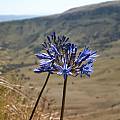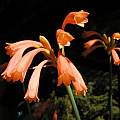You can always check the PBS wiki (Agapanthus praecox (link)) if there is any doubt about the bulbiness of anything. We're not so bothered on the forum - any sort of plant is OK. It is agapanthus flowering time here at the moment. My modest efforts are being out classed by my neighbour's huge clump of flowers.
(link)) if there is any doubt about the bulbiness of anything. We're not so bothered on the forum - any sort of plant is OK. It is agapanthus flowering time here at the moment. My modest efforts are being out classed by my neighbour's huge clump of flowers.



